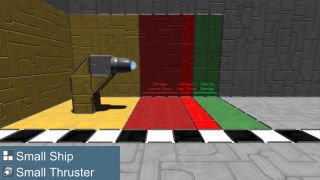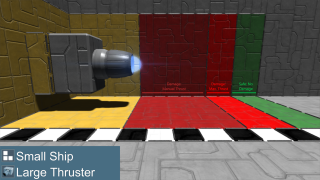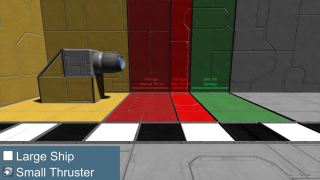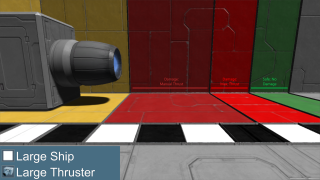Thruster
Thrusters for both small and large ships require energy and apply two different kinds of thrust. A thruster applies its maximum rated thrust value (the highest value the override slider can be set to) when using the movement keys. While automatically dampening the thrusters apply 10 times that rated thrust value. This means a ship will stabilize faster if the pilot does not activate any manoeuvring controls.
To calculate how many thrusters you need, use Newton's Second Law, specifically the formula F=ma. Here F is force in newtons, m is the mass of the ship in kilograms and a is the desired acceleration in meters per second2. For additional ease of use it may be helpful to think of a as the final velocity (in meters per second), minus the initial velocity all over time (in seconds). Using this definition of a=(vf-vi) / t it is possible to choose a speed of travel and the time it will take your craft to reach it. In terrestrial terms this would be akin to the zero to 60 metric for cars. By dividing your calculated force by the listed thrust of the engine you choose, you arrive at the number of thrusters needed.
For example, if you have a 2 million kg large ship that needs to accelerate 5 m/s2 you would use the following equation. F = 2,000,000 kg x 5 m/s2, resulting in 10 MN thrust required. Large thrusters for large ships produce 3.6 MN of force. 10 MN divided by 3.6 MN gives you a total of 2.78. This is the number of large thrusters you would need both to accelerate and manually brake. If you apply the other definition of acceleration you can find the time it takes your ship to reach an arbitrary speed. If you let your cruise speed equal 100 m/s the equation solved for time will be t = v / a. Substituting the values in results in a zero to 100 time of 20 seconds for this particular ship. It's important to note these calculations only hold true for manual firing of the thrusters. Automatic inertial dampening will produce much higher forces and therefore lower times to zero velocity, in this case approximately 2 seconds.
Currently thrusters act in a purely linear fashion and do not turn vehicles. See Gyroscope for information on rolling and turning.
Contents
Thrusters
| Block | Icon | Mass for Small ships (kg) | Mass for Large ships (kg) | Description |
|---|---|---|---|---|
| Small Thruster | |
|||
| Large Thruster | |
Small Thrust
A small component to create thrust for your ship.
Large Thrust
A large component to create thrust for your ship.
Thruster Characteristics
Small Ships
| Force (N) | Power (kW) | Mass (kg) | ||
| Small Thruster | Normal | 12 000 | 201 | 93 |
| Dampening | 120 000 | 201 | ||
| Large Thruster | Normal | 144 000 | 2 400 | 721 |
| Dampening | 1 440 000 | 2 400 | ||
Large Ships
| Force (N) | Power (MW) | Mass (kg) | ||
| Small Thruster | Normal | 288 000 | 3.36 | 4380 |
| Dampening | 2 880 000 | 3.36 | ||
| Large Thruster | Normal | 3 600 000 | 33.6 | 43200 |
| Dampening | 36 000 000 | 33.6 | ||
- Dampening values only apply when Inertial Dampeners are activated and no thrusters are being fired manually.
Thruster Damage
If 'Thruster Damage' is enabled for a map or server, thrusters will deal damage while active to any blocks directly behind within a certain distance. If this occurs, blocks adjacent to the block/s in "the line of fire" will also be damaged in a cross-pattern. If the block is too close to the thruster, this can even damage the thruster, causing it to explode. The "danger zone" varies in size based on the thrust being applied by the thruster. Large thrusters deal damage further than small thrusters. Likewise, thrusters on large ships deal damage further than those on small ships.
This table (and the images below it) indicate the damage distances for small and large thrusters and ships. They apply only to blocks directly behind the thruster, and do not account for damage to adjacent blocks.
| Damage Distance with Manual Thrust... |
...and with Max. Thrust (Dampeners) | ||||
| Blocks | Metres | Blocks | Metres | ||
| Small Ship | Small Thruster | 3 sb | 1.5m | 4 sb | 2.0m |
| Large Thruster | 5 sb | 2.5m | 7 sb | 3.5m | |
| Large Ship | Small Thruster | 2 lb | 5.0m | 3 lb | 7.5m |
| Large Thruster | 5 lb | 12.5m | 6 lb | 15.0m | |
- sb = small-ship blocks (0.5m each)
- lb = large-ship blocks (2.5m each)



